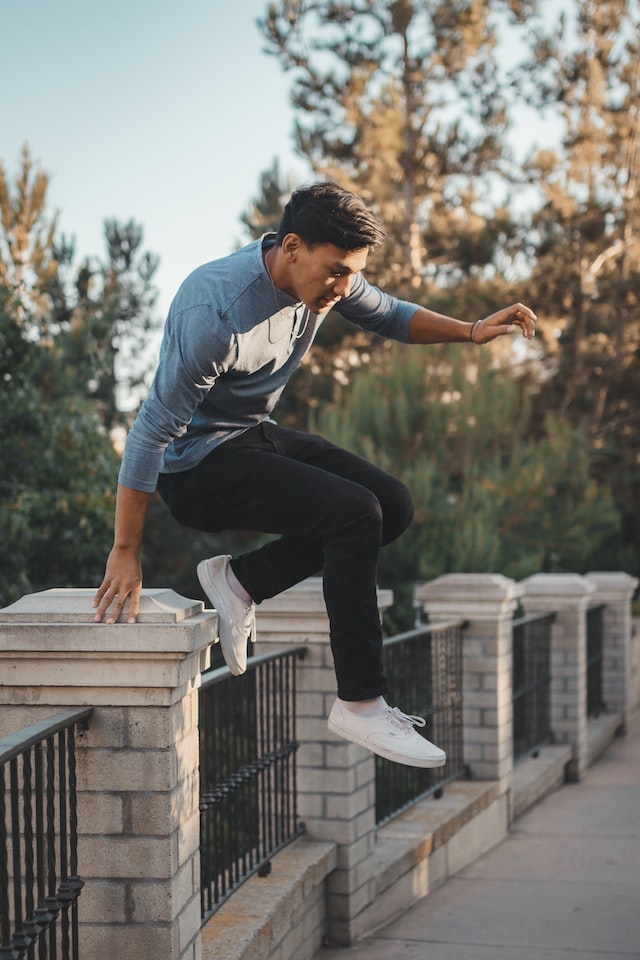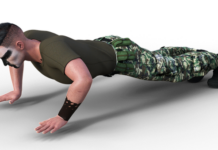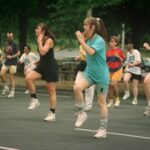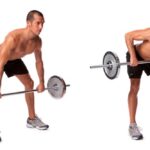Jumping is an impulse from a surface generating force and speed to fall on the same place or another one further away.
It is a primary skill in the exercise of many athletes. In basketball or volleyball, for example, it is a fundamental practice.
It is also used in competitions and even in physical evaluation tests in some professions such as physical educator, police officer, etc…

Jump Types:
- Simple: encompasses the largest probable distance.
- Simple in race: 15 to 20 meters of route ending in a jump.
- Continuous: making successive jumps, one after the other.
- Continue in the race: run from 10 to 15 meters making jumps with the feet together.
- Jump one leg: repetition of jumps to a single leg.
- Jump one leg alternately: several jumps landing on a different leg in each one.
Correct position to jump:
To get more height you have to rehearse the steps before the jump to get more energy. This energy will generate further momentum.
You have to concentrate for a moment to visualize the jump and meditate on the sequence to be performed.
This skill takes a lot of work. The key is to focus on the legs, mainly the hips, knees and ankles.
There is no exclusive technique for jumping; the only applicable one is the repeated performance of the exercises. The most important thing is to keep your body and back straight.
The support must be done on the balls of the feet to gain speed and the arms must flex at the same time as the hips in the execution. The strategy lies in the speed of the descent.
The neck must be placed upwards with the gaze in the same direction so as not to lose sight of the angle of the jump. The ankles should be kept extended as much as possible during the flight action.
It is true that the morphology of each person in developing a better jump also influences, since a person with longer legs will make a jump of greater distance.
Another of the less commonly talked about features is about white muscle fibers, since these are genetically originated and cannot be generated by training.
A person who possesses these characteristics will have a greater capacity to travel greater distance in the impulse.
On the other hand, it is also important to note that people with a stronger and more toned lower body are able to achieve better jumps.
In any case, there are activities that increase our performance and improve the jump, we tell you some techniques.
Exercises to train and jump higher:
Double leg jump:
Stand with your feet shoulder-width apart. The knees should point out.
Lower your body into a squat position with your arms extended toward the ground.
Then prepare to jump by pushing the balls of your feet as much as possible and as quickly as you can.
Moving your arms up helps to gain more momentum. Finally, landing is controlled by resting on the toes, bending the knees slightly.
Depth Jump or Depth Jump:
For this exercise, you should stand in front of a not very high step or bench.
Take distance to make a jump and land on the balls of the feet bending the knees.
Next, a new jump is made on the site as high as possible.
The size of the step is progressively increased and the type of fall is interspersed, varying its landing.
This will help get used to any type of position.
Jump with one leg:
Stand straight with one foot shoulder-width apart and one leg bent back.
A set is exercised in the half forward bend stance while in the half squat position.
The arms should hang effortlessly by the sides of the body in the direction of the ground.
Raising the latter as high as possible while the jump occurs and lowering quickly to finish placed on the back.
Landing occurs on the balls of the feet and with the knees bent.
On the other hand, it is important to obtain good leg muscles and exercise them in order to create a better impulse.
Exercises to build leg strength:
Squats:
Stand up straight or lean against a wall, aligning your knees with your shoulders. Acquire the squat position to the level of the knees.
Repeating this exercise strengthens the gluts and quads.
Calf stretch:
It is done on a step with support only on the balls of the feet.
Short jumps are executed on the spot and the exercise can be accompanied by the use of some type of weight to increase resistance.
Hamstring and gluten stretches:
This exercise is carried out in a seated position and with the legs fully stretched forward.
The objective is to grab the balls of the feet with both hands and bring them towards our body.
This stretches the tendons and increases flexibility.
Jump practice:
Doing this workout often with high-intensity movements increases your heart rate.
In this way, the fast-twitch muscle fibers are exercised, generating better jumps.
Performing the exercises accompanied by weights increases the results.
Exercises to increase your flexibility:
Stretching and increasing your flexibility will improve the stiffness of your muscles and help you gain better jumping technique.
With a stretching routine you will reduce muscle soreness from training, improve performance and reduce the risk of injury.
In addition, this practice will improve your circulation, increasing blood flow to your muscles.
A series of basic positions for stretching are:
- Get up and bend over with your arms outstretched.
- Hip-rotation.
- Sitting crossing one foot over the opposite leg and turning the trunk backwards.
- Neck rotations.
- Over-the-shoulder stretch.
Tips for jumping high:
- Each progress takes time, measure your progress for weeks.
- Jumping rope can be a very effective training exercise as it increases your cardiovascular capacity and perfects your muscles.
- Step classes can be a good ally.
- Build your muscle memory with exercises that improve your ability to propel yourself higher.
- Train often to increase your strength and improve your endurance.
- Avoid injuries by warming up your muscles before jumping.
- Always land on the balls of your feet.
Tricks to help you gain a few inches by jumping:
One of the secrets is to relax the hip, because if we contract it, the gluts will also do so and a negative reaction will occur in the jump.
In addition, by generating tension, pain can occur in the days after exercise. To avoid stiffness of the hip we must perform the following stretch before the exercise:
Get on your knees with a straight back and move one leg bent in a reverse L forward, so that the foot is flat on the ground.
Grab the instep of the other leg and pull it towards your back. Repeat this same action changing the position to the opposite leg.
Lift weight a few minutes before the exercise to activate the power of your muscles immediately (The time to perform the jump afterwards should not exceed 4 to 8 minutes).
Avoid possible shoelaces:
When we begin to exercise and work the muscle we must prevent the appearance of painful stiffness.
Having soreness is normal and they usually appear 24 or 48 hours after exercising. Later they disappear thanks to rest and a healthy diet.
Soreness always begins progressively; it is important that we start a new exercise gradually and gradually increase the pace.
Warming up is an important technique to accustom the body and increase body temperature.
It is also essential to stretch after training, for at least ten minutes, to recover your muscles.
Perform proper hydration and replenish your energy with nutritious foods.
Eat a healthy and balanced diet:
One of the important factors to improve your jumps is food; you must eliminate fats from your diet.
It includes carbohydrates to store energy, fibers and proteins to maintain muscle tissue.
We recommend starting the day with a breakfast rich in low-sugar cereals and fruit.
Your meals should be mainly a source of carbohydrates such as potatoes, bread, pasta and rice.
Add foods rich in protein such as fish, dairy, poultry, etc.
Among some of the foods that make you gain more strength are sunflower seeds, turkey or chicken meat, red meat, soy, eggs, broccoli and spinach.
Consult a dietitian to match proper nutrition to your training program.
Finally, we advise you to combine your jumping training with other types of sports such as cycling or football; it will help you exercise more of the lower part of your body.

















